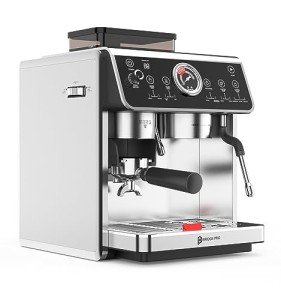The Rise of Home Espresso Machines: A Comprehensive Guide
As coffee lovers continue to look for fresh and tasty brews in your home, the popularity of home espresso machines has actually surged in current years. No longer simply the domain of coffee shops and coffee stores, these machines empower individuals to craft barista-quality espresso drinks from the comfort of their kitchens. This post will explore the numerous kinds of home espresso machines, their functions, and considerations for picking the ideal one. Additionally, it will provide a choice of FAQs to assist prospective purchasers make informed decisions.
Kinds Of Home Espresso Machines
Home espresso machines can be classified into a number of categories based on their mechanisms and user-friendliness. Each type has its unique features, pros, and cons.
| Type | Description | Pros | Cons |
|---|---|---|---|
| Manual Espresso Machines | Requires the user to manually manage the brewing process, involving techniques like pulling a lever to produce pressure. | - Complete control over brewing procedure - Compact style | - Requires skill and practice - Time-consuming |
| Semi-Automatic Machines | Machine automates water circulation and pressure, however the user still controls the dosing and period of the brewing procedure. | - Balance of automation and control - Versatile | - Learning curve for refining techniques |
| Fully Automatic Machines | Automates the whole brewing procedure, from grinding to developing, often with programmable settings for customized beverages. | - Extremely easy to use - Quick and practical | - Less control over the brewing process - Higher rate point |
| Capsule or Pod Machines | Utilizes pre-packaged espresso capsules or pods to create coffee rapidly and easily. | - Extremely simple to use - Minimal clean-up | - Limited taste range - More costly per cup than ground coffee |
| Super-Automatic Machines | Combines features of totally automatic machines with built-in grinders, allowing users to brew whole bean espresso and milk-based beverages with one touch. | - All-in-one convenience - Ideal for milk-based beverages | - Often the most expensive - Can be bulky |
Functions to Consider
When selecting a home espresso machine, possible buyers must consider the following features to guarantee they pick a machine that fulfills their requirements:
Grinder Type:
- Built-in mills can supply fresher premises however might need more upkeep.
- Separate grinders permit more customization of grind size.
Pressure:
- Look for machines that produce at least nine bars of pressure, which is optimum for brewing espresso.
Water Temperature Control:
- Machines with adjustable temperature level settings enable much better extraction of taste from beans.
Milk Frothing Options:
- Consider whether you want a manual steam wand for frothing or an automatic milk frother for benefit.
Alleviate of Cleaning:
- Machines with removable parts and self-cleaning functions substantially minimize clean-up time.
Size and Design:
- Ensure the machine fits comfortably in your kitchen area and aligns with your aesthetic preferences.
Budget:
- Set a budget before beginning your search, as costs can vary significantly from affordable designs to high-end machines.
Advantages of Home Espresso Machines
Owning a home espresso machine uses many benefits:
- Cost-Effective: Over time, brewing espresso in your home can save coffee enthusiasts cash compared to regular café visits.
- Customization: Users can explore different beans, grind sizes, and brewing methods to find their ideal cup.
- Convenience: The capability to brew espresso at any time removes the need to head out to a café, particularly advantageous during late nights or mornings.
- Quality assurance: With a home machine, individuals have total control over the quality of active ingredients and developing processes.
Downsides of Home Espresso Machines
Nevertheless, there are some downsides to think about:
- Initial Investment: High-quality espresso machines can be pricey, needing a substantial in advance financial investment.
- Learning Curve: Mastering the art of espresso brewing can require time and practice, which might be intimidating for novices.
- Upkeep: Like any appliance, espresso machines need regular cleansing and upkeep to make sure optimal efficiency.
FAQs
1. What is the very best kind of home espresso machine for beginners?
Response: For novices, a semi-automatic machine is often suggested as it offers a balance in between control and automation, enabling you to learn the essentials without frustrating intricacy.
2. How much should I spend on a home espresso machine?
Response: Entry-level machines can begin around ₤ 100 to ₤ 300, while higher-end models can vary from ₤ 500 to over ₤ 2000. It's important to set a budget based upon your expected usage and wanted features.
3. Do Dual Boiler Espresso Machines require a different grinder?
Response: While some espresso machines include integrated mills, buying a separate grinder permits higher personalization and guarantees much better quality premises.
4. How frequently should I clean my espresso machine?
Response: Cleaning frequency can differ by machine type, but it's typically recommended to clean up the machine after each use and perform deep cleanings weekly or monthly, depending upon use.
5. Can I make milk-based drinks with any espresso machine?
Answer: Not all machines come with milk frothing abilities. If you enjoy drinks like lattes or cappuccinos, try to find a machine with a steam wand or automatic frother.
Home espresso machines are transforming the method coffee enthusiasts enjoy their beloved brews. With numerous types and advanced functions readily available in the market, there is something for everybody. Whether it's the pleasure of developing special dishes or simply savoring the best shot of espresso, purchasing a home espresso machine can improve both the coffee-drinking experience and the lifestyle for coffee enthusiasts all over. As with any investment, it is important to weigh the benefits against the possible drawbacks and pick a machine that perfectly fits both your way of life and preferences.

